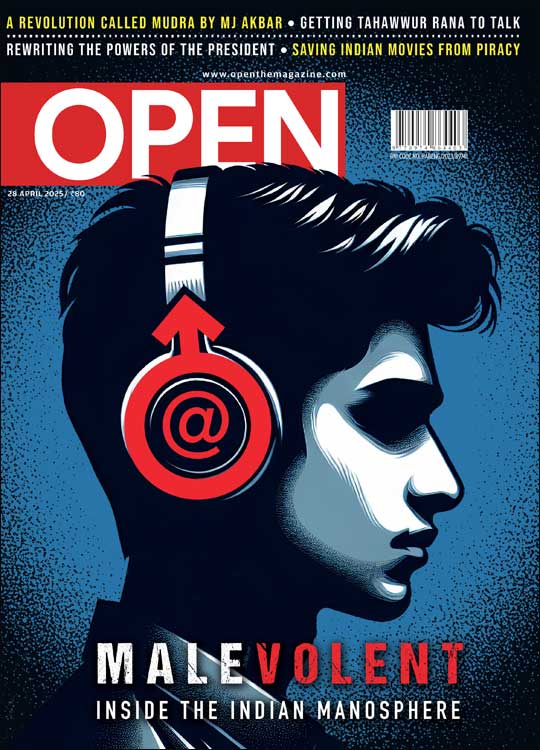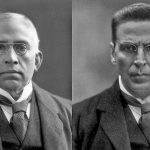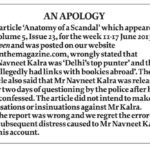The High of Hidden Words
As the second edition of the only national crossword competition gets underway, we take a look at the intriguing close-knit community of the best solvers in India
 Madhavankutty Pillai
Madhavankutty Pillai
 Madhavankutty Pillai
Madhavankutty Pillai
 |
11 Sep, 2014
|
11 Sep, 2014
/wp-content/uploads/2015/11/Hiddenwords-main.jpg)
As the second edition of the only national crossword competition gets underway, we take a look at the intriguing close-knit community of the best solvers in India
Crosswords entered Vinayak Ekbote’s life when he was in school in Hyderabad in the late 70s. The Hindu newspaper used to come home and he would try to solve the crossword getting just a clue or two right. The habit continued into engineering college but he lost touch once he came to Delhi to study at the Indian Institute of Foreign Trade. He then went to Russia for five years and it was only after his return to Delhi that, sporadically, he would again go at it. Once, in the early 2000s, on a flight from Delhi to Hyderbad, he shocked himself by unexpectedly solving an entire crossword, something he had only done a couple of times. But even then it was only an occasional indulgence.
That has changed. Ekbote, a 48-year-old engineering consultant, now solves at least two crosswords daily. As soon as he gets up, he downloads The Hindu newspaper’s crossword on an app in his phone and then works on it over 40 minutes. If it is not completely solved, he keeps going at it for the rest of the day. “I also do one more crossword, usually of The Telegraph, UK,” he says. What turned Ekbote’s fledgling interest into a semi-obsession was running into ‘The Hindu Crossword Corner’ (Thehinducrosswordcorner. blogspot.com), a blog by a retired army colonel, Deepak Gopinath.
Cryptic crosswords follow a certain system. The clue will read like an ordinary sentence but within it lies the encrypted answer. One part of the sentence will have the ‘definition’, another part the ‘word play’—both will indicate the solution. Within this structure, a number of elements are encrypted. The answer could be hidden in the sentence itself; there might be a double definition; an anagram of the solution may be buried somewhere, and so on.
But Ekbote, despite his many years at crosswords, hadn’t really known the rules. He just worked by instinct. In Gopinath’s blog, he found the solution to The Hindu crossword put up daily with explanations of the clue type.
As example, take a couple of clues of this Monday’s Hindu crossword. The 10 Across clue was ‘Scan cervix to reveal tumour (6)’. Gopinath put it up on his blog as ‘Scan cervix to reveal tumour (6) CANCER (T)’. It shows that the answer ‘Cancer’ was hidden in the clue. Similarly, the 9 Down clue was ‘Woody growth in the middle of road (4)’ and Gopinath put it up as ‘Woody growth in the middle of road (4) TREE (sTREEt)’. The definition here is ‘Woody growth’, which indicates ‘Tree’. The wordplay is ‘in the middle of road’; another word for ‘road’ is ‘street’ and so the middle of the first and last letters of ‘street’ would be ‘tree’.
“Every day,” says Ekbote, “[Gopinath] deconstructs the clue, breaking it up into the relevant elements and arriving at the solution. So if you regularly go through the blog, you will know the techniques to employ.”
Last year when the Indian Crossword League, a national competition, was organised for the first time, he expected Gopinath to be in the top ten. And Ekbote, who eventually came 12th himself, was not really surprised when Gopinath won top honours, thus becoming the unofficial crossword champion of India because this is the only such competition in the country.
This year the Indian Crossword League starts on 14 September. There will be 10 weekly online rounds and an offline final of the top ten in December. The League is the brainchild of an IAS officer, Vivek Kumar Singh, who is currently the principal secretary, environment and forest department, of the Bihar government. His interest started in college in Delhi and he went on to be the crossword setter of the Indian Airlines magazine Swagat for over a decade, besides publishing a book on cryptic crosswords. Last year, he realised it was the 100th anniversary of the first published crossword and decided to use the occasion to give India’s crossword culture a boost.
“Crossword has primarily been a private pursuit. I thought, ‘Why not make it competitive?’” he says. He started with an all India inter-school crossword contest that has now been adopted by CBSE. “Then I also got the Indian Crossword League organised for a general open category,” he says. They had eight online rounds and the finals of the top ten was held in Bangalore. Here, there were two rounds. In the pre-final, the contestants had to solve a Crossword in 30 minutes and based on that six went through to the finale, which Gopinath narrowly won.
Gopinath, who stays in Bangalore, gets up at quarter-to-six in the morning and takes his dog out for a walk. He returns home and starts solving The Hindu crossword, which is online a little after 6. At 8.30 am, the solution gets uploaded onto his blog. There are annotations explaining the clues and even some humourous elements like cartoons and quips to spice it up. Gopinath has been doing this everyday with military discipline ever since he started the blog in 2009.
Last year, most of the finalists were regular The Hindu crossword solvers and there is a reason why it has so many adherents. It is the only newspaper that sets its own crosswords; other papers mostly syndicate them from UK publications. For Colonel Gopinath, the time taken to solve the crossword ranges from half an hour to two hours but there are also days when he does not get everything. “But I still publish the solution with a couple of blanks,” he says. A large number of crossword solvers are meanwhile waiting for Gopinath to upload it in case they need to understand a clue or to generally exchange comments on their experience solving it. Gopinath keeps up this interaction for the rest of the morning
His interest in crosswords began in college in Coimbatore in the early 70s. It continued in the Army, especially when he was posted to remote areas. It was after his retirement in December 2006 that crosswords became an inviolable part of his daily routine. When he first started the blog, it had no visitors. But then, whenever a solver who was stuck for a word of that day’s Hindu crossword would google, it would land him or her to his blog, which already had the solution. “That’s why it caught on and people got attracted to it,” he says. Even the setters of the The Hindu crossword are regular visitors now. He and those who frequent his blog have also had offline meetings four or five times in Chennai and Bangalore. Last year, it was through a comment that he realised there was a Crossword League being held and decided to take part. And when he reached the offline finals, he found that of the ten, five were personally known to him through his blog.
“The youngster who came second was only 21 years old and he was very good. In the first (pre-final offline round) crossword which everyone had to solve in half an hour, none of us could get everything right. But he got the maximum,” says Gopinath. He is referring to Mohsin Ahmed, a Bangalore based scientist from ISRO who has a reputation in the crossword community for being very quick and sharp.
Ahmed got his interest from his mother, an avid solver of The Hindu crossword. ‘I found it quite intriguing and surprisingly managed to pick up on the rules pretty quickly. This was about seven-odd years back, when I was in school,’ he says over email. ‘There was a bit of a competitive element too, as I’d try to out-solve my mother. I sometimes snuck the paper in my bag, took it to school and solved it in a particularly boring period.’
The thing about cryptic crosswords is that it takes time and patience to pick up, but once you get the idea then it never stops being a challenge. ‘There’s no dearth of words in the English language,’ he says, ‘And given a word, 10 different setters would clue it in 10 different ways. Cryptic crossword setters are an extremely innovative bunch. There’s always a challenge.’
He gives the example of an interesting clue—‘Tree is rife with bananas (5,3)’— that appeared as part of a Hindu crossword set by Buzzer (Bhavan Kumar). Ahmed says, ‘First note how smooth the reading of the clue is. There’s nothing to suggest that it’s a cryptic statement. Also, (5,3) indicates the number of letters in the solution. Here, the answer has 2 words of length 5 and 3 letters respectively. You can split this clue as: Tree (=definition) // is // rife with bananas (=wordplay). Now for the wordplay part: The answer is an anagram of (rife with). ‘Bananas’ also means ‘crazy’ (as in ‘He’s bananas’). So it is an indicator of an anagram (that is, the letters RIFE WITH have gone crazy/bananas… which suggests a reshuffling of letters). On playing with the letters, you get the answer WHITE FIR, which is a tree, as indicated by the definition.’
In the competition last year, Ahmed finished on top at the end of the online rounds and even in the offline pre-final round where they had to solve a crossword in 30 minutes. ‘But in the final round, the Colonel managed to pip me to the post,’ he says.
Gopinath, according to him, is one of the best solvers in the country. But the Colonel has decided not to compete this year and Mohsin is one of the favourites to win the competition.
Shuchismita Upadhyay, an infotech professional from Bangalore who came fifth in the Crossword League last year, has a popular blog, Crosswordunclued.com, in which she has interviewed many of the best Indian crossword solvers. She says the thing that is common to all of them is persistence: “The learning curve is steep with cryptic crosswords. It is very easy to start and then see that you are not able to solve anything and then give up. Everybody took time to learn. Whoever has become a good solver really had that persistence to understand which clues they are missing, spending time and effort on it.”
Upadhyay began the blog because her own experience showed how lonely a pursuit crossword solving can be. Her father used to ask her to read The Economic Times to get a grasp of finance, and she got interested in the crossword. She had no clue how to go about it and would look at the solution of the next day to understand how they worked. “I was about 13, in Delhi,” she says, “I didn’t know anyone else who solved crosswords, so I didn’t have anybody to tell me. I would spend a lot of time [trying] to understand why something was the clue.” Later on, she saw there was a crossword community on Orkut and joined them. She also started reading books. In 2008, when she started the blog, it was to show beginners how the technical aspects worked. “All my old blogs are more like tutorials for new solvers. Then I started posts on evaluating clue types, reviews about different crosswords and so on.”
Her blog also has what is probably the first ever Hindi cryptic crossword that she, along with another setter, created. “Cryptic crosswords are not really happening in regional languages. The one we set must be the first of its kind. At least I have not heard of Hindi cryptic crosswords before we wrote one for the blog.” She has interviewed setters too and finds that their personalities often come through in the crosswords they set. “If you see Neyartha’s crosswords in The Hindu, there will be a lot of science-based clues in it. There is a setter (in the UK) called Anax who used a lot of play on verb and noun formations. He would use a word like ‘sandwiches’ (which reads as a noun) on the clue surface but actually is a verb in the cryptic reading. If you are solving a setter’s clues over a period of time, you tend to look out for this kind of word play,” she says.
An interesting post by her is on a retired Indian scientist, S Naranan, who analysed 3,404 crosswords he had attempted over a decade to find out if there is a pattern to the unsolved clues, and came to an interesting conclusion. Says Upadhyay, “What S Naranan is trying to say is that—and this works for solvers who nearly complete the crossword— suppose you have a large volume of crosswords solved by a person and if you know how many are there with ‘n’ number of errors and how many with ‘n+1’ number errors, then you can predict the whole pattern.” So if a person has solved 1,000 crosswords, and in those 1,000 he has missed one answer in so many number of crosswords and missed two in so many others, then it can be predicted in how many crosswords he has missed three clues, how many has he missed four and so on. Naranan published a paper on this in 2010 in the Journal of Quantitative Linguistics.
Upadhyay does a crossword, usually The Times UK one, early in the morning, and, if time permits, one or two more over the day. She finds it difficult to explain what drew her to crosswords except that it is probably something hardwired into her. And as with all the others, she has to get that daily high of hidden words. She says, “If I pick up a newspaper I simply have to look for the crossword in it.”

/wp-content/uploads/2025/04/Cover-Manosphere.jpg)











More Columns
The Pontiff Who Led by Example Sudeep Paul
Find the Best App for Personal Loans Open Avenues
Truth or Lies? Nandini Nair